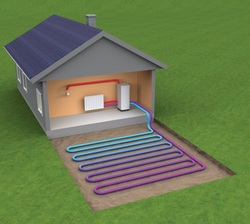Heat your home with energy absorbed from the ground.
Ground source heat pumps use buried pipes to extract heat from the ground. This is usually used to heat radiators or under floor heating systems and hot water.
Beneath the surface, the ground stays at a fairly constant temperature, so a ground source heat pump can be used throughout the year – even in the middle of winter.
How Does A Ground Source Heat Pump Work?
A ground source heat pump circulates a mixture of water and antifreeze around a loop of pipe – called a ground loop – which is buried in the ground. Heat from the ground is absorbed into this fluid and is pumped through a heat exchanger in the heat pump.
Low grade heat passes through the heat pump compressor and is concentrated into a higher temperature useful heat capable of heating water for the heating and hot water circuits of the house. Ground loop fluid, now cooler, passes back into the ground where it absorbs further energy from the ground in a continuous process while heating is required.
The length of the ground loop depends on the size of your property and the amount of heat you need – longer loops can draw more heat from the ground, but need more space to be buried in.
Normally the loop is laid flat, or coiled in trenches about two metres deep, but if there is not enough space, you can install a vertical loop down into the ground to a depth of up to 200 metres. This is known as a bore hole.
Heat pumps have some impact on the environment as they need electricity to run, but the heat they extract from the ground is constantly being renewed naturally. To avoid the environmental burden, these systems can be coupled with a Solar PV System, the electricity generated allows you to run your Ground Source Heat Pump heating system for free!
Beneath the surface, the ground stays at a fairly constant temperature, so a ground source heat pump can be used throughout the year – even in the middle of winter.
How Does A Ground Source Heat Pump Work?
A ground source heat pump circulates a mixture of water and antifreeze around a loop of pipe – called a ground loop – which is buried in the ground. Heat from the ground is absorbed into this fluid and is pumped through a heat exchanger in the heat pump.
Low grade heat passes through the heat pump compressor and is concentrated into a higher temperature useful heat capable of heating water for the heating and hot water circuits of the house. Ground loop fluid, now cooler, passes back into the ground where it absorbs further energy from the ground in a continuous process while heating is required.
The length of the ground loop depends on the size of your property and the amount of heat you need – longer loops can draw more heat from the ground, but need more space to be buried in.
Normally the loop is laid flat, or coiled in trenches about two metres deep, but if there is not enough space, you can install a vertical loop down into the ground to a depth of up to 200 metres. This is known as a bore hole.
Heat pumps have some impact on the environment as they need electricity to run, but the heat they extract from the ground is constantly being renewed naturally. To avoid the environmental burden, these systems can be coupled with a Solar PV System, the electricity generated allows you to run your Ground Source Heat Pump heating system for free!
- The benefits of ground source heat pumps
- Reduce your fuel bills, especially if you are using Oil, LPG or electric heating.
- Reduce your carbon footprint
- No fuel deliveries required.
- Can provide space heating and hot water
- It’s often classed as a ‘fit and forget’ technology because it needs little maintenance.


